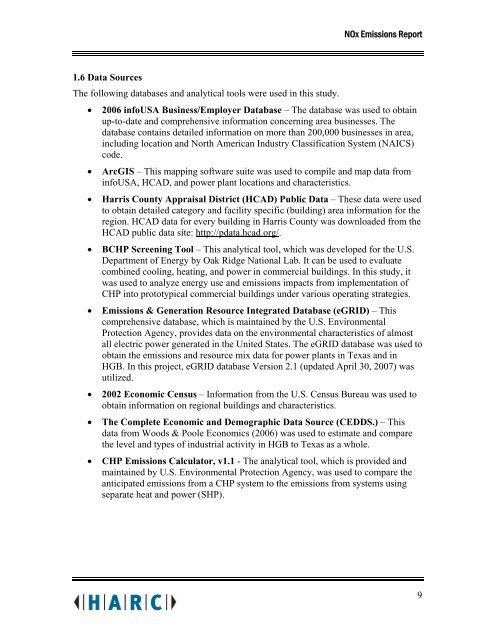NOx Emissions Impacts from Widespread Deployment of CHP in ...
NOx Emissions Impacts from Widespread Deployment of CHP in ...
NOx Emissions Impacts from Widespread Deployment of CHP in ...
You also want an ePaper? Increase the reach of your titles
YUMPU automatically turns print PDFs into web optimized ePapers that Google loves.
<strong>NOx</strong> <strong>Emissions</strong> Report<br />
1.6 Data Sources<br />
The follow<strong>in</strong>g databases and analytical tools were used <strong>in</strong> this study.<br />
• 2006 <strong>in</strong>foUSA Bus<strong>in</strong>ess/Employer Database – The database was used to obta<strong>in</strong><br />
up-to-date and comprehensive <strong>in</strong>formation concern<strong>in</strong>g area bus<strong>in</strong>esses. The<br />
database conta<strong>in</strong>s detailed <strong>in</strong>formation on more than 200,000 bus<strong>in</strong>esses <strong>in</strong> area,<br />
<strong>in</strong>clud<strong>in</strong>g location and North American Industry Classification System (NAICS)<br />
code.<br />
• ArcGIS – This mapp<strong>in</strong>g s<strong>of</strong>tware suite was used to compile and map data <strong>from</strong><br />
<strong>in</strong>foUSA, HCAD, and power plant locations and characteristics.<br />
• Harris County Appraisal District (HCAD) Public Data – These data were used<br />
to obta<strong>in</strong> detailed category and facility specific (build<strong>in</strong>g) area <strong>in</strong>formation for the<br />
region. HCAD data for every build<strong>in</strong>g <strong>in</strong> Harris County was downloaded <strong>from</strong> the<br />
HCAD public data site: http://pdata.hcad.org/.<br />
• B<strong>CHP</strong> Screen<strong>in</strong>g Tool – This analytical tool, which was developed for the U.S.<br />
Department <strong>of</strong> Energy by Oak Ridge National Lab. It can be used to evaluate<br />
comb<strong>in</strong>ed cool<strong>in</strong>g, heat<strong>in</strong>g, and power <strong>in</strong> commercial build<strong>in</strong>gs. In this study, it<br />
was used to analyze energy use and emissions impacts <strong>from</strong> implementation <strong>of</strong><br />
<strong>CHP</strong> <strong>in</strong>to prototypical commercial build<strong>in</strong>gs under various operat<strong>in</strong>g strategies.<br />
• <strong>Emissions</strong> & Generation Resource Integrated Database (eGRID) – This<br />
comprehensive database, which is ma<strong>in</strong>ta<strong>in</strong>ed by the U.S. Environmental<br />
Protection Agency, provides data on the environmental characteristics <strong>of</strong> almost<br />
all electric power generated <strong>in</strong> the United States. The eGRID database was used to<br />
obta<strong>in</strong> the emissions and resource mix data for power plants <strong>in</strong> Texas and <strong>in</strong><br />
HGB. In this project, eGRID database Version 2.1 (updated April 30, 2007) was<br />
utilized.<br />
• 2002 Economic Census – Information <strong>from</strong> the U.S. Census Bureau was used to<br />
obta<strong>in</strong> <strong>in</strong>formation on regional build<strong>in</strong>gs and characteristics.<br />
• The Complete Economic and Demographic Data Source (CEDDS.) – This<br />
data <strong>from</strong> Woods & Poole Economics (2006) was used to estimate and compare<br />
the level and types <strong>of</strong> <strong>in</strong>dustrial activity <strong>in</strong> HGB to Texas as a whole.<br />
• <strong>CHP</strong> <strong>Emissions</strong> Calculator, v1.1 - The analytical tool, which is provided and<br />
ma<strong>in</strong>ta<strong>in</strong>ed by U.S. Environmental Protection Agency, was used to compare the<br />
anticipated emissions <strong>from</strong> a <strong>CHP</strong> system to the emissions <strong>from</strong> systems us<strong>in</strong>g<br />
separate heat and power (SHP).<br />
9
















